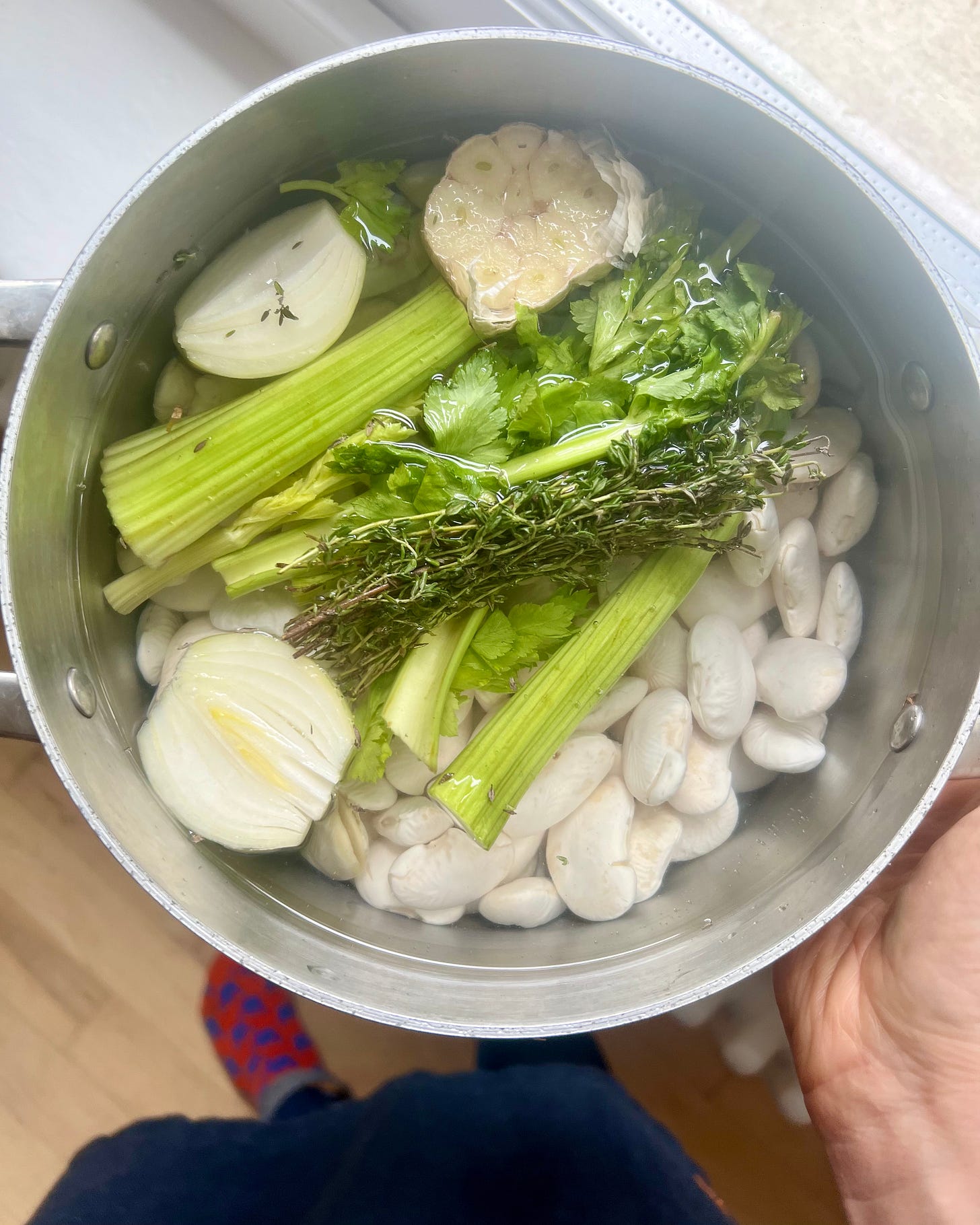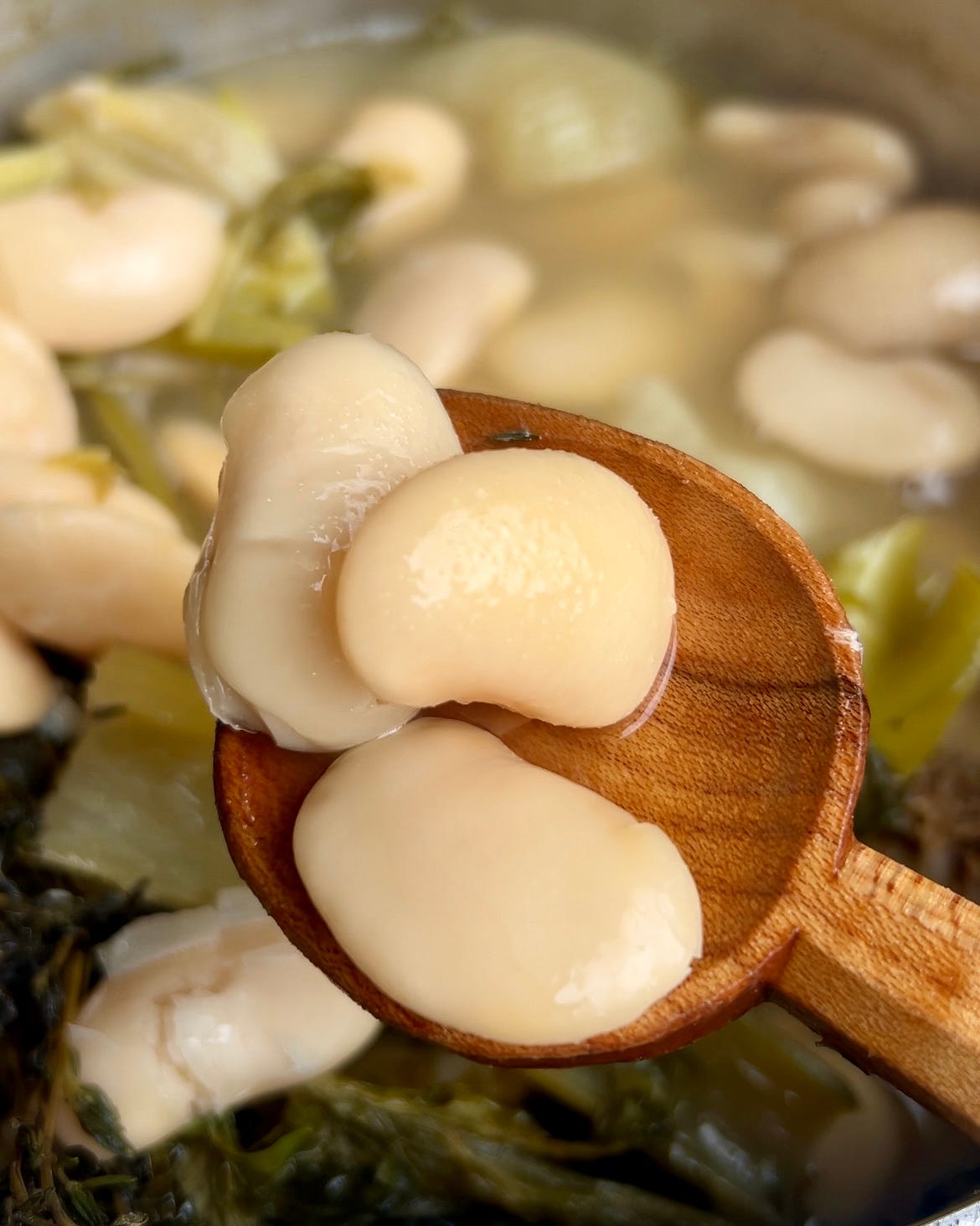Yesterday’s hippy food is today’s store cupboard essential … and your favourite food writers’ favourite weapons.
Even fifteen years ago, who would have predicted that pulses, the dried then reconstituted seeds of legume plants (i.e. beans, lentils, peas), would be as trendy and loved in contemporary western kitchens as they now appear to be.
If the pulses are jarred, they’re ‘quick and easy’. If they’re dried, they’re ‘cheap and nourishing’. Whatever form you purchased them in, they’re high in fibre and protein; good for the gut microbiome; as ‘nitrate-fixers’ they’re good for the soil; and they are, quite simply (and perhaps most importantly), good to eat. Indeed, pulses make an excellent side dish. Most are flavoursome in their own right, and they are all extremely effective carriers of bold flavours.
In my humble but relatively well-eaten opinion, butter beans (for Spanish speakers, ‘Judion’) are the best of them. Properly cooked, the texture of these plump, kidney-shaped pulses are (drum roll) … buttery. As in ‘buttery’ when the butter has been in your shopping bag for an hour or so before getting home. There’s a hint of resistance at first, but that quickly abates, turns smooth and eventually melts in the mouth. The flavour, if well seasoned, is intensely savoury and deliciously beige. I love them.
Maybe you do too. Maybe you *think* you don’t. Either way, I hope the thoughts, tips and recipes in this piece are of interest.
How to serve butter beans
‘How to cook’ is covered a little bit further on. But it’s helpful to quickly mention at the top that there are (at least) four ways of serving butter beans (or indeed any pulse). These are worth keeping in mind when imagining what you might be eating them with, or how they could be embellished.
Brothy — the broth that results from slowly cooking beans and aromatics for a couple of hours is delicious and should not be wasted. I like to serve beans in a shallow bowl, sitting like hippos bathing in ‘a puddle’ of flavoursome liquid (embellished with a glug of olive oil). It’s not a soup, but there’s enough broth that you’d either have a spoon or some bread nearby to mop up them up. Which probably means there’s a ladle’s worth of liquid, maybe a touch more.
Saucy — i.e. where the beans are shrouded in a glossy sauce. Might be tomato or cream-based, or just a bucket-load of extra virgin olive oil (see the recipes at the bottom of this post for one of each). You might also squash or purée approximately 1/4-1/3 of the beans, loosened with the cooking broth, which thickens the liquid and a creates a viscous, savoury-creamy sauce.
Dry-ish — where the beans are strained of most of the cooking juices. In most cases you’d want to then coat them with olive oil or a sharp dressing, or perhaps jumble the beans with a number of other ingredients.
Smashed or pureed — cooked butter beans are inherently soft, smooth and smashable. Butter beans are particularly good, and are especially luscious if loosened with some of the cooking broth broth and/or olive oil.
Side note: as well as being a decent meat and two veg-style side, butter beans are great in a buffet/feasting platter or small-plates scenario. In part because they’re versatile and accommodating. But also because they’re still mighty enjoyable if left to cool to room temperature.
Butter beans go especially well with
A lot of things. But they always come to mind when cooking:
Slow roast lamb shoulder or shanks, and also faster cooked lamb chops;
Sausages, pork chops, porchetta;
An intense and perhaps sweetly-spiced beef braise, stew or casserole;
Flaky white fish, such as cod, pollock, haddock. Also trout, mackerel and sardines;
Braised portobello mushrooms, roasted bell peppers dotted with cherry tomatoes, anchovies and garlic; and
Eggs. Of course! Fried is fine, but best are poached or runny/jammy-yolk boiled eggs. There is, of course, a butter bean and egg dish in my new book Good Eggs. (Sorry … but also, do grab a copy please and thank you.)
Serve alongside
One of my favourite ways to eat butter beans is when there’s nothing else alongside … albeit there are other ingredients jumbled, winding and wilting through them. Think: slow-cooked (or barely cooked) courgettes; any brassica, spinach, chard, rocket; roasted peppers, cherry tomatoes, sweet corn and so on.
However if you do want separate vegetables, then:
Roast or braised alliums and bulbs, such as red onions, stuffed white onions, confit garlic or fennel;
Roast squash or sweet potatoes — with either these puréed or smashed, or left whole with the butter beans then in mushy form;
Any of the greens and vegetables mentioned above as being good when stirred through beans;
Charred brassicas, like hispi (sweetheart) cabbage or wedges of red cabbage; and
Sweet green vegetables, such as asparagus, sprouting broccoli, mangetout and sugar snap peas.
Useful condiments and seasonings
Butter beans are not bland. But they do love heavy-handed seasoning. This might be in the form of:
A really peppery extra virgin olive oil or nutty cold-pressed rapeseed oil;
Finely grated or flaked Parmesan, pecorino, ricotta salata, or any salty hard cheese;
Also fresh soft cheeses, such as feta, ricotta, a soft goat’s cheese such as a Perroche, burrata;
Chilli, whether in the form of flakes, a dash of hot sauce, chilli oils, or fresh chilli-flecked vinaigrettes;
Pork. Which might mean rendered and crisp pancetta or lardons. But might also mean ‘nduja, sobrasada or lardo, which become molten in the residual heat of the beans, and can then be stirred through, thickening and flavouring any sauce/broth;
Sharp pops of flavour from things like roast or sun-dried tomatoes, olives and tapenade;
Lemon juice, soft fresh herbs (dill, mint, parsley, tarragon, chervil), and sage (butter beans LOVE sage); and
Aromatic spices and spice blends, such as black peppercorns, nutmeg, za’atar, cumin and salt.
How to cook butter beans
From dry
Requires virtually no hands-on work, but does need a little organisation / time.
Cover dry beans with twice their volume in water and leave for 12 hours (or more). Initially their jackets with expand faster and things look unpromising, but hang tight.
Drain. Transfer to a saucepan that comfortably holds them and again cover with twice their volume in water. Add aromatics that happen to be in the fridge — things like celery, onion, garlic, old carrots, one or two cherry tomatoes, thyme, sage, rosemary, bay leaves, black peppercorns. Bring to an energetic simmer, then reduce the temperature and simmer very gently for around 3 hours (recipes often say 2 hours, but slow and gentle is best for creamy, flavoursome results). Once soft and smooth (easily squashable between thumb and forefinger), then they’re done.
Remove the aromatics, season generously and embellish as you wish (see recipes below) and/or store in the fridge until required.
In terms of quantity, cooked beans end up a touch more than 2.5 x their weight when dry. By way of example, 300g dried butter beans becomes 650g-700g once soaked for >12 hours, and increase a touch more to 750g-800g once cooked. This is enough for 4-8 servings, depending on appetite and style of dish. They’ll last for 3 days if refrigerated, so are an excellent batch cook.
From cooked
Buy jarred beans. Canned beans are much cheaper … but not as flavoursome, gently cooked or enjoyable. I like Bold Bean Co and Navarrico — both are premium, beautifully cooked and seasoned. Also available (in the UK) and good, are Perello, Belazu and I’m sure others.
Decant beans and liquid from jar to wide saucepan. Simmer gently for 4-5 minutes, reducing and thickening the liquid a little.
Embellish as you wish, either with condiments and seasonings (as above), or in the style of the recipes below.
That’s it.
Pureed
Once heated, use a fork, potato masher, hand held blender to mash or puree the beans, or shove them in a food processor. Add cooking liquid or oil, little by little, to loosen to desired consistency. I think a little texture is good, so avoid a blender unless aiming for something very smooth.
Extra reading
There are a number of ideas for butter beans (and other white beans, plus chickpeas and lentils) in my cookbook On The Side.
See also a handful of great (I think) bean recipes in my book Crave. Specifically: braised, minted courgettes with butter beans and soft cheese; beans simmered with strips of pork belly until both are so soft they can be cut by a spoon, then topped with a deli olive tapenade; and another sage, onion, sausage and borlotti bean dish (although these could easily be subbed with butter beans).
Joe Woodhouse always offers excellent pulse inspo. See his cookbooks Your Daily Veg and More Daily Veg.
’s books Nothing Fancy and Dining In are strong on beans.And Bold Bean Co’s cookbook is a rich source of top bean-led dishes.
Recipes
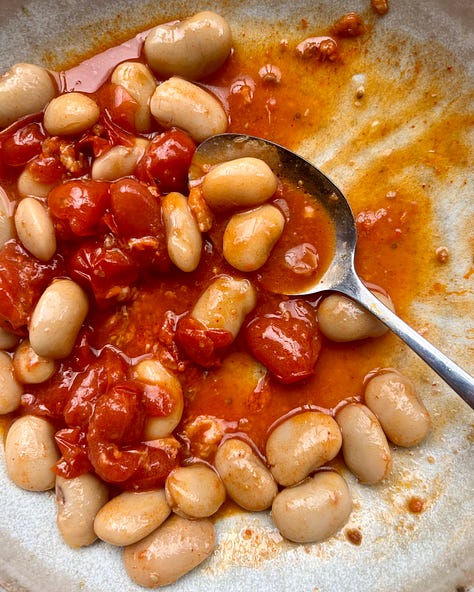
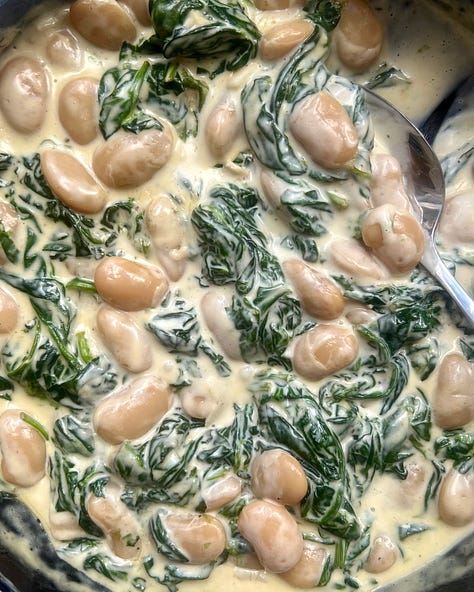
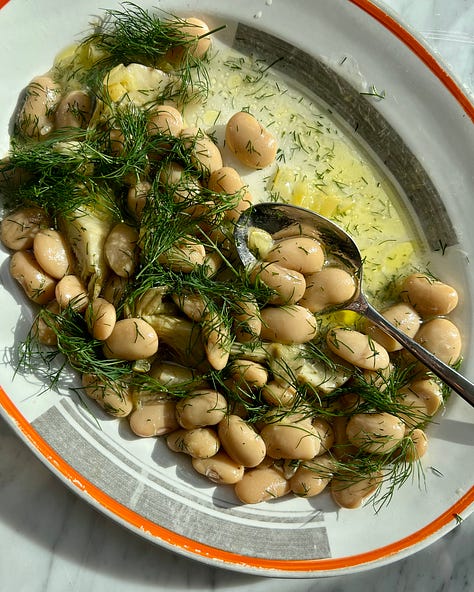
The possibilities are endless, to be honest. But I’ve landed on three quite different ways to embellish your butter beans (whether home-cooked or shop-bought. Each take just a few minutes and very little effort to put together (if the beans are already cooked). And each is an absolute belter.
Sobrasada and cherry tomato butter beans
Creamed spinach (and other things) butter beans
Preserved lemon, dill and artichoke butter beans
There are suggestions for each as to what centrepieces and sides they’d pair well with. I think they’re extremely tasty, will prove useful, and that you’ll cook them on repeat.
All the details are below the paywall. As is a 20% discount code for Bold Bean Co. products, which if you use it just once, effectively covers the cost of a month’s subscription. (Not an advert, just a perk for paid subscribers — I plan to find and offer more as the newsletter grows.)






